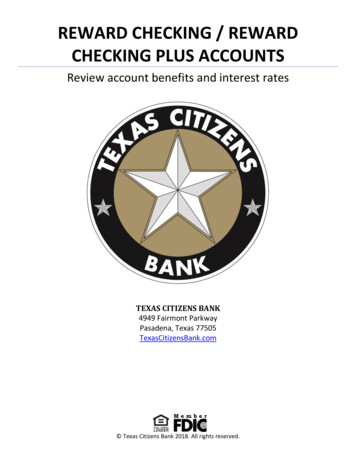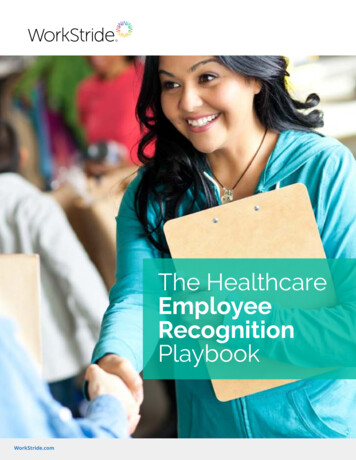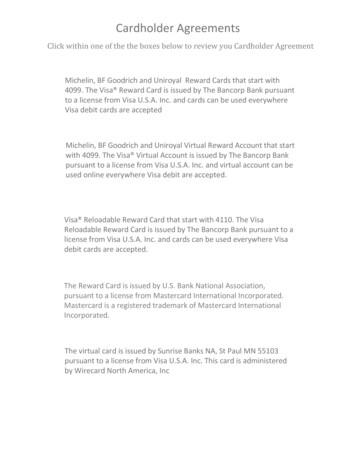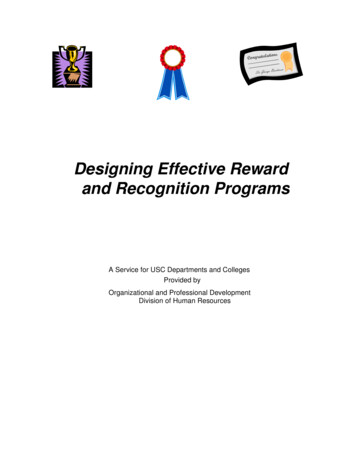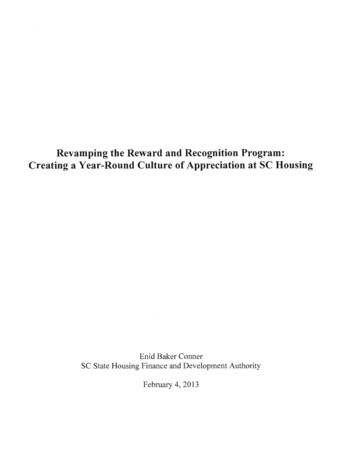
Transcription
Revamping the Reward and Recognition Program:Creating a Year-Round Culture of Appreciation at SC HousingEnid Baker ConnerSC State Housing Finance and Development AuthorityFebruary 4, 2013
Table of ContentsProblem StatementPage 1Data CollectionPage 2Data AnalysisPage 5RecommendationsPage 8Implementation PlanPage 10Evaluation MethodPage 13SummaryPage 13References
Problem StatementEvery organization wants a highly engaged, motivated and productive workforce. Studieshave shown that organizations with above average levels of employee engagement also havehigher levels of productivity, lower turnover, higher profits and higher customer satisfaction(WorldatWork and NAER). Many factors, such as advancement opportunities, work/life balanceand work environment play important roles in motivation and productivity, but a key driver ofemployee engagement is reward and recognition (R&R).Research shows that nearly nine out of ten companies offer some type of R&R program(WorldatWork, Trends in Employee Recognition), but that is not to say all of them are effective.An effective program does not take a "one size fits all" approach to R&R. Just as all employeesare different, varied types of rewards and recognition are needed. To be effective, R&R shouldbe seen as attainable by all employees, presented in a timely fashion, offered on a regular basis,and consist of various types of recognition, informal as well as formal.The existing Reward and Recognition program at South Carolina State Housing Financeand Development Authority (SC Housing) has not been a focus over the past 10 years and iscurrently very limited. The parts ofthe program we have in place are good, but they arepredictable and for the most part, recognize employees only at certain times ofthe year.The scope of this project is to evaluate our current R&R efforts, both agency-wide and byindividual managers, and develop ideas to enhance the program. A primary goal is to discoverhow managers are recognizing their employees, how often and for what behaviors employees arebeing recognized and how satisfied the employees are with those efforts. With tight budgets areality for the foreseeable future, we want to identify no to low cost ways that we can recognizeour employees day to day. We would also like for our R&R efforts to be consistent throughout1
the agency and this will require commitment from all levels of management. We also want toidentify the different ways in which employees would like to be recognized. Ultimately, the goalis to offer a more holistic approach to R&R, not just by giving awards and planning appreciationevents.In the absence of a truly effective R&R program, there is missed potential for the agencyin the areas of promoting desired behaviors, as well as boosting morale. The enhanced R&Rprogram will incorporate values that align with the agency's strategic goals and business needs,therefore reinforcing key employee behaviors that our agency needs to remain sustainable andstrong in the future. Employees will see greater value demonstrating these values and behaviorsif their efforts are supported through a variety of recognition methods. In addition, the agencywill also have a greater opportunity to boost employee morale and motivate all employees, notjust our high performers, with our R&R efforts.In 2003, the South Carolina Human Resources Division (SC HRD), formerly known asthe Budget and Control Board's Office of Human Resources, developed a service to assist stateagencies in developing effective reward and recognition systems. HRD's publication outlinesnine steps that agencies can take, from the "pre-work" stage, through the design of the processand on to evaluating, improving and providing for ongoing support of the process. HRD's modelwill be used as a basis for the enhancements to SC Housing's current program. This project willtake our program from HRD's pre-work stage of the program and into Step 3, "Developing theParameters of the Process". Recommendations for the design and implementation of ourrevamped R&R program have been made after review of the research.Data CollectionCurrent policies were reviewed to determine the formal R&R programs in place at this2
time and the cost of these programs. Older policies were examined to determine what formalprograms were in place within the last ten years.Currently, SC Housing' s Human Resources Department plans an annual EmployeeAppreciation Day luncheon in May; State and Agency Service Awards are given out at that time.We recognize employees at 10, 20, 30, 40 and 50 years of state service. Our Executive Directorpresents the employee with a state service pin and a certificate during the function. In addition,employees who have 10 years of service with SC Housing receive a commemorative brick inrecognition ofthe service achievement. Members of senior staff provide door prizes that aregiven to employees at this event.Other employee functions coordinated by Human Resources include the annual holidayangel tree lighting, the annual holiday luncheon and two other small functions during the year. Inaddition, member of the agency' s senior and executive staff are responsible for planning anannual employee picnic. Employee participation in these events is high.We also allow casual dress days on Fridays and with the approval of the ExecutiveDirector, on the day before a holiday. Some departments allow flexible work schedules; whetheror not this is allowed is up to the department director within each department.At one time, SC Housing had an "Employee of the Month" and "Manager of the Month"program in place; the "Employee of the Year" and "Manager of the Year" were then selectedfrom those managers and employees. Up until 2006, the agency gave awards for two"Outstanding Employees" each year, in January and July. More substantial monetary awardswere associated with each of these programs.The Kudos Award program recognizes "individuals who actively contribute to the overall3
success of the agency". A nomination has to be approved by the Division Director, HumanResources Director and Executive Director. If approved, the nominee is able to order an itemfrom a pre-selected list of vendors for a specified dollar amount. This program is not widely usedand only full time employees are eligible. As research into the effectiveness ofthe Kudosprogram, the number of awards that were processed over the past five years was reviewed.To determine what individual managers were doing on an informal basis in theirdepartments, a survey of all management staff was developed using the web-based applicationSurveyMonkey. Information sought included what types ofR&R the managers provided to theiremployees, as well as what type of behaviors and how timely they provided thereward/recognition. The survey asked what they felt motivated their employees and asked themto rank the importance of various R&R methods. They were also asked to rank the characteristicsemployees should be rewarded for exhibiting. In addition, the survey asked what their employeesdid to show appreciation to their peers. The survey was sent to 35 members of management and17 responses (49%) were received.A second survey was developed and administered to all employees. This included themanagers who received the management survey, to determine what types ofR&R they receivedfrom their managers.The survey asked employees what types of R&R their managers provided to them, forwhat type of behaviors and how timely the reward/recognition was provided. They were asked togive an overall rating of their manager's effectiveness in R&R efforts. The survey asked whatmotivated them to do a good job and requested they rank the importance of various R&Rmethods. Employees were also asked to rank the characteristics they felt they should berewarded for exhibiting. In addition, the survey asked what they did to show appreciation when a4
co-worker helped them out. Last, the survey asked in what setting they like to be recognized. Thesurvey was sent out to 131 employees and received 72 responses (55%) were received.In addition to the surveys, general web and print research was done on successful R&Rprograms, specifically seeking low to no cost ways to reward and recognize employees.Information on Employee of the Month and Employee of the Year programs was also sought.Data AnalysisTypes of RecognitionThe surveys asked the questions "How are you recognizing your employees?" of themanagers and "What does your manager do to recognize you?" of the employees. The surveysinquired about sixteen specific types of recognition; they also asked both groups to specify thefrequency of the recognition. The responses were grouped into "Always/Frequently","Occasionally/Seldom", and "Never" categories.A positive finding in comparing the responses of employees and managers is that in tenof the sixteen types, employees confirmed that they were receiving the recognition that themanagers said they were giving. The variances between the managers' and the employees'responses were less than 20%, with the exception of the following six categories:F 'r'Y;'"""'',.,. ' '"'I'I!T'" r -,ili !!'m'o/* '7.,. .,. . , .:;. · . . . . ,.··.· .·: -: : ;, -:(A:'. -' 'd1J.Uiw .e. 1. ,.,!JL.!; .,.v,,,,-·-,.,. ,""l: 7 " -·if'/'?'. -i-"T',''"'CT'""!"'.,: :: '" · :-fl: ::·; 'i'. :. : - ; : ·-: ;:· ( : .: :.- : .:, :;'::-4 a jk"" . '1D .J &:.J"'rj!:.Written thank you e-mail or noteDepartmental lunchesDepartmental partiesPublic recognitionLunch with individual EE'sChoice of job assignment, autonomy, e results show that managers believe they are providing the R&R types above in largeramounts than the employees believe they are receiving it. However, in looking at these six types5
of recognition that showed a disconnect, only one (the written thank you e-mail or note) was inthe types of recognition that employees ranked as being very important to them.MotivatorsWhen employees were asked what motivates them to do a good job and managers whatmotivates their employees to do a good job, the results are as follows:Pay increase or bonusVerbal or written thank youKudos award or other monetary giftLunch or food brought inEmployees86%78%35%24%Managers75%94%50%38%These results show that SC Housing's employees are more motivated by pay increasesthan thanks, but by only a 12% variance. While employees say that managers do a good job ofexpressing thanks over all, 31% of the employees ' responses said they never receive a writtenthank you; closing this gap could have a significant impact on employee motivation.When asked to rank what behavioral competencies should be recognized or rewarded,managers and employees ranked excellent customer service first (see top 4 in table below).234TeamworkExceeding performance goalsPositive attitudeExcellent customer servicePositive attitudeTeamworkExceeding performance goalsManagers said that customer service is a top competency, yet when we asked employeeswhat type of behaviors or actions they are receiving rewards for, only 5% of employees say theyare recognized for customer service. The largest percentage (36%) of employees surveyed saidthey received recognition for meeting and/or exceeding their performance goals. However, thenext largest percentage (20%) of respondents noted that they receive either negative feedback or6
none at all (refer to chart below). When responses were filtered by management responses only,the managers showed a slightly higher rate of negative feedback or no feedback at all (22.7%).*These behavioral competencies are a compilation of information gleaned from several differentmeetings with the training committee, our senior staff retreat and through a business criticalcompetency survey previously administered to senior staff. Two ofthese competencies, customerservice and teamwork, are characteristics measured on every employee's annual EPMSevaluation.Monetary RewardsAlso, 35% of employees say that they are motivated by Kudos or other monetary award,yet the Kudos award is not being used by managers or employees to the degree that it could be.There are some key issues with the Kudos award that render it ineffective: too few employees arerecognized, the presentation of it is not timely, as it requires the approval ofthree levels ofmanagement and the criteria is non-specific. Employees and managers are aware of the Kudosaward but it is not promoted and is underutilized. In five years out of the six studied, less thanten employees received a Kudos award per year (see chart below).Kudos Recipients per Year20 152007 20081050I2007 20092008I I200920107 I20112012 2010 2011 2012
The research on Employee of the Month (EOM) programs showed that while mostorganizations used to have one in place, they are trending down. Dr. Aubrey Daniels (Daniels,page 153) says of the Employee of the Month programs: "the practice violates every knownprinciple of effective recognition and positive reinforcement". Dr. Daniels explains that whileEOM programs are intended to have a positive effect on employee motivation, they cansometimes have the opposite effect. He considers the EOM program ineffective because theyare: not specific about what must be done to receive the award; neither timely nor frequent;assume that everyone would appreciate the same type of award; allow for only a few winners.Recommendations:Our current R&R program is not hitting the mark. Our challenge is to create a year roundculture of appreciation, where all employees feel valued every day, not just in May on EmployeeAppreciation Day or if they are one of the few employees who receive a Kudos award. Ouremployees say that most important reward is a pay increase but this is followed closely by averbal or written thank you. Pay increases are generally tied to the EPMS evaluation andadministered one time per year, thus minimizing tying financial incentives to timely R&R. Asimple verbal or written thank you costs nothing and can be given immediately. Employeesranked years of service dead last as a characteristic that should be recognized, but state andagency service awards is our most visible method of recognition at this time.The scope of this project is to make recommendations that will assist a future R&Rcommittee with setting high level parameters (HRD) for our program enhancements. Based onthe results of the surveys and research, following are five recommendations that should assistthis committee in the initial and design stages:8
Recommendation 1In the employee survey, 78% of our respondents said they are motivated by verbal orwritten thanks. The number one recommendation is to make managers aware of the valueemployees place on verbal and written thanks and give them tools to say "thank you". OCTanner has a free e-card program called "iappreciate" that can be provided to managers or themarketing department could create an e-card that managers may send to their staff, both FTE andtemporary.Almost 92% of employees said they recognized co-workers through verbal or writtenthanks. An e-card developed in-house would also allow employees to recognize their peers.Recommendation 2Because the review of the Kudos program records showed that the program isunderutilized, the challenge is to create a more user friendly aspect of SC Housing's R&Rprogram that is attached to a monetary award. The second recommendation is to replace thecurrent Kudos program with the "Raise the Roof' program. The award could be linked to the topsix performance and behavioral competencies that managers and employees believe should berecognized or rewarded (excellent customer service, positive attitude, teamwork, exceedingperformance goals, willingness to accept additional responsibility, innovation and creativity).The first "Raise the Roof' that an employee receives each quarter would be entered into adrawing with five winners selected each quarter. Winners would be able to order an item from apre-selected list of vendors for a specified dollar amount, as the Kudos are now. This woulddouble the number of awards of this type currently given. Another suggestion for an awardwould be an assigned parking space for the quarter, which would hold high value to ouremployees as parking becomes a premium at our building.9
Recommendation 3To bring awareness to R&R, the third recommendation is to spotlight several employeesquarterly in the employee newsletter for exhibiting one or more of our six behavioralcharacteristics. Care would need to be taken in the method of selection and to ensure that theemployees spotlighted are comfortable with public recognition and represent the variousdepartments within our agency.Recommendation 4Customer service was rated the number one competency by employees and managers butonly 5% of employees felt they received R&R for customer service. Recommendation 4 is tocreate a customer service award to recognize employees for excellence in customer service, typeof award to be determined by the R&R committee.Recommendation 5Dr. Aubrey Daniels suggests that companies who have EOM programs in place eliminatethem "as quietly and painlessly as possible" (Daniels, page 153). Also, in a study of recognitionprogram trends, the Employee of the MonthlYear programs are trending down. Only 29% ofcompanies surveyed in 2012 use the Employee of the Month/Year award, down from 32% in2005 (Trends in Employee Recognition).For these reasons, the fifth recommendation is do not reinstate an Employee of the Monthprogram. Instead, use available resources to develop and implement the "Raise the Roof" award.Implementation PlanAction Steps for the scope of this project1.Present recommendations to the Executive Staff for approval10
2.Make any suggested revisions3.Work with Executive Staffto select a R&R Champion4.Form an R&R committee which will be tasked with setting the high level parameters(HRD) of the revamped program, such as determining:a. The final behavioral characteristics that will be rewardedb. What types of R&R will be put in place (manager to employee, peer to peer, ora combination)c. Dollar amount to be allocated for each type of recognitiond. How to select the team tasked with the design, implementation and monitoringof the programAction steps for the future1. Designing the enhancements to the program2. Training managers on changes to program3. Promoting the enhanced program4. Rolling out the enhanced program5. Evaluating the enhanced programThe Design Committee, which will include Human Resources, will be responsible for thesefuture steps. In addition, the Marketing Department will share in responsibility for the promotionof the enhancements.Timeframes and Costs The current costs for our employee recognition efforts were analyzed and it isrecommended that the agency could allocate an additional 20% of our R&R budget forFY12/ 13 toward the recommended R&R enhancements.11
The timeframes for implementing the various parts of the program are:Developing and implementing thank you e-cardsMay 2013Excellence in customer service awardsJuly 2013Recognizing employees in the agency newsletterJuly 2013Designing and implementing "Raise the Roof' awardsSeptember 2013Potential Obstacles As other programs have been rolled out other at SC Housing, we have realized that weneed to reinforce changes with a variety of methods. We have to ensure we have thesupport of managerial staff and that our R&R efforts are not stand alone, but integratedinto other employee and organizational development methods to include strategicplanning, gap analysis, and succession planning.Potential Resources Marketing Department will be a resource in developing e-card programs for manager toemployee, and peer to peer recognition and also in promoting the enhanced program Human resources contacts at other state agencies who have in place R&R monetaryawards similar to the proposed "Raise the Roof' award Contacts at other southeastern Housing Finance AgenciesIntegration into Standard Operating Procedure Managers will be trained on the enhancements to the current program and the newprogram will be promoted to employees. Whatever enhancements are made to, or cutfrom, our current program will become part of our Reward and Recognition Policy.12
Evaluation Method Develop a reward and recognition success survey, asking specifically aboutenhancements to the program. To measure the effectiveness ofthe program enhancements from an employee standpoint,develop a survey to administer after the changes have been in place for 6 months andagain at 12 months. The R&R committee will determine which behavioral competencies will be linked to theagency' s strategic goals. Develop a managerial survey to measure any increase inemployees exhibiting these competencies, to be administered after 6 and 12 months afterchanges have been implemented.SummaryHuman Resources is many times saddled with the responsibility of reward andrecognition and ideally this project will result in a toolbox that managers will be able to use, onethat includes various types ofR&R. One result that the managerial survey showed was that whilethe current human resources team was recognized as having made much greater R&R effortsthan past teams, managers still need and want new creative and low cost ways to recognize theiremployees. Recommendations have been made that, if implemented, will provide managers withrecognition methods that do not cost a great deal of money, yet have a good "return onreward/recognition" (HRD). The goal is to raise awareness, educate managers on the benefits ofR&R and make changes, however small at first, to move the needle.13
ReferencesDaniels, Aubrey. Bringing Out the Best in People: How to Apply the Astonishing Power ofPositive Reinforcement. New York: The McGraw-Hill Companies, 2000. Print.Harter, J. K., F. L. Schmidt, and T. L. Hayes. "Business-unit-level relationship betweenemployee satisfaction, employee engagement, and business outcomes: a meta-analysis." JournalofApplied Psychology (2002): 268-279. Print.Nelson, Bob and Dean Spitzer. The 1001 Rewards and Recognition Fieldbook. New York:Workman Publishing Company, Inc., 2003. Print.South Carolina Human Resources Division, Designing Effective Reward and RecognitionSystems, A Service for SC State Government Agencies, 2003. Print.Virginia Department of Human Resources Management, Employee Recognition ProgramHandbook, September 2003. WebWorldatWork, Trends in Employee Recognition, May 2011.Web.WorldatWork and National Association for Employee Recognition (NAER), 2003 RecognitionSurvey, September 2003, Web.
employee engagement is reward and recognition (R&R). Research shows that nearly nine out of ten companies offer some type of R&R program (WorldatWork, Trends in Employee Recognition), but that is not to say all of them are effective. An effective program does not take a "one size fits all" approach to R&R. Just as all employees


